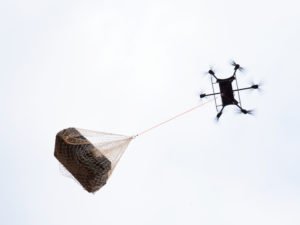
Drone provider ZM Interactive (ZMI) today released the next generation of its xFold drones. The Dragon can lift up to 1,000 pounds, while the Dragon Hybrid boasts a flight time of 1.5 hours on battery and more than 8 hours with a hybrid system.
The xFold line can switch among several rotor modes, including x4 (four rotors), x6 (six), X8 (eight) to X12 (12) configurations in minutes. Pilots can deploy robotic arms for delivery, extinguisher ball droppers for firefighting, sprayers for agriculture or sensors for 3D mapping.
The military grade commercial drones are designed, manufactured, built and assembled by ZMI in the U.S. using proprietary components. The aircraft are weather resistant and made to fly in inclement conditions, a company spokesperson said.
“The xFold Dragons by ZMI are built to be the strongest, most adaptable aircraft on the market today,” said ZMI CEO Ziv Maron. “We are constantly improving on our designs to make them suitable for every industry and every use. Our customers come to us with an idea and our technology continues to rise to the challenge – these capabilities are only the beginning and we have more exciting updates coming in 2021.”
ZMI clients using the xFold Dragon include Dynatics, NASA JPL, Livermore Labs, Israel Defence Force, US Military, USDA, police and fire departments, as well as Bell Helicopter, which was granted FAA Experimental Registration on multiple xFold drones in 2019.
In January, the California-based company will present a demo in San Francisco and will feature heavy cargo delivery, including to offshore vessels, as well as long-distance operations and search-and-rescue operations.
In other ZMI news
ZMI picked Iris Automation as its detect-and-avoid provider in March. The deal will empower ZMI customers to conduct beyond visual line of sight (BVLOS) operations.
Using the IRIS platform, ZMI will provide the option of equipping its drone platforms with Iris Automation’s Casia system. Described as a “turnkey solution,” Casia detects, tracks and classifies other aircraft and makes informed decisions about the threat they could potentially pose to the UAS. To avoid collisions, Casia triggers automated maneuvers, and alerts the pilot in command of the mission.
Jason is a longstanding contributor to DroneLife with an avid interest in all things tech. He focuses on anti-drone technologies and the public safety sector; police, fire, and search and rescue.
Beginning his career as a journalist in 1996, Jason has since written and edited thousands of engaging news articles, blog posts, press releases and online content.
Email Jason
TWITTER:@JasonPReagan
Subscribe to DroneLife here.